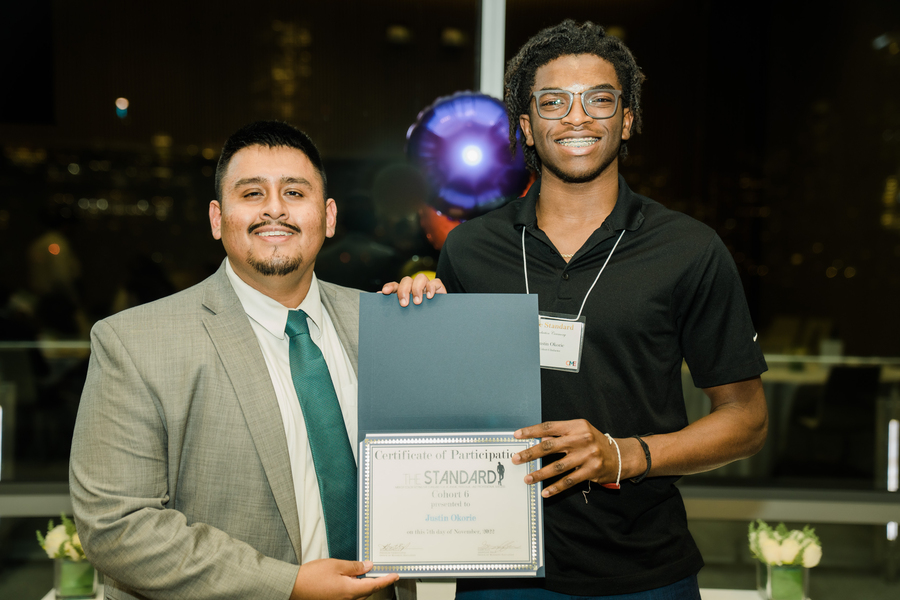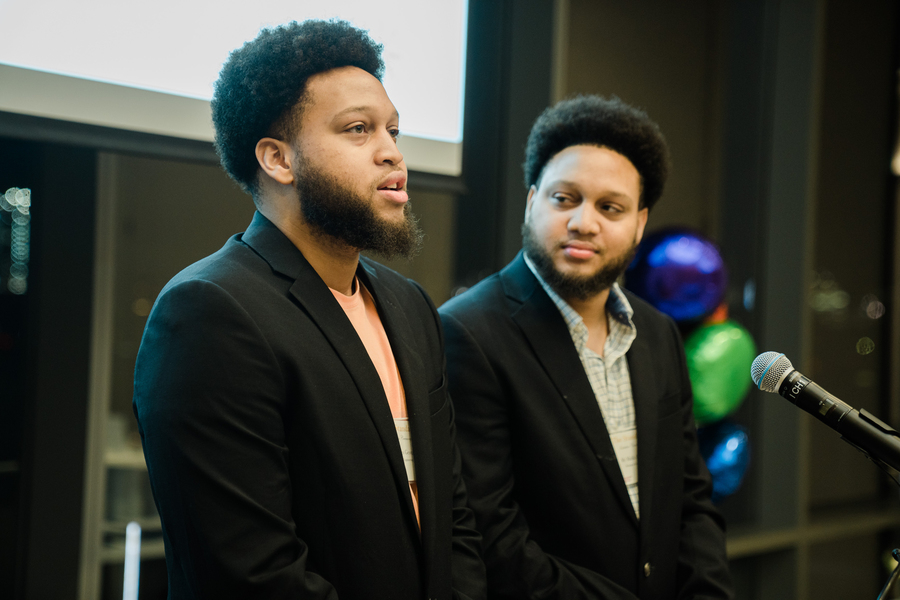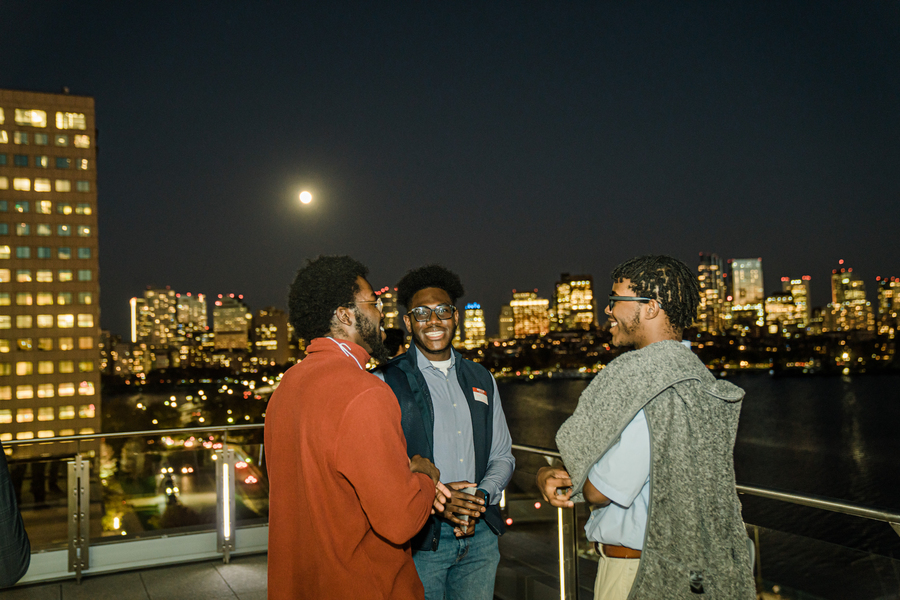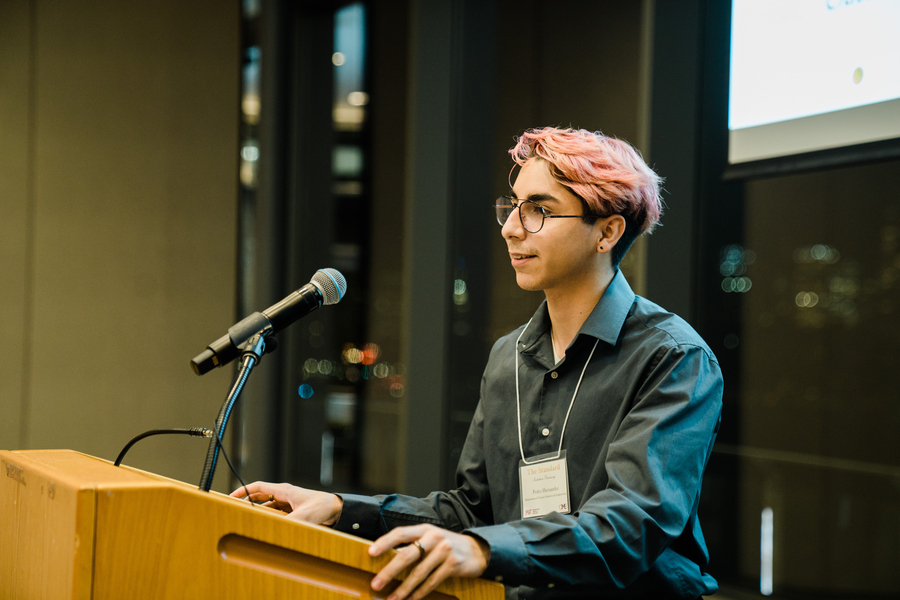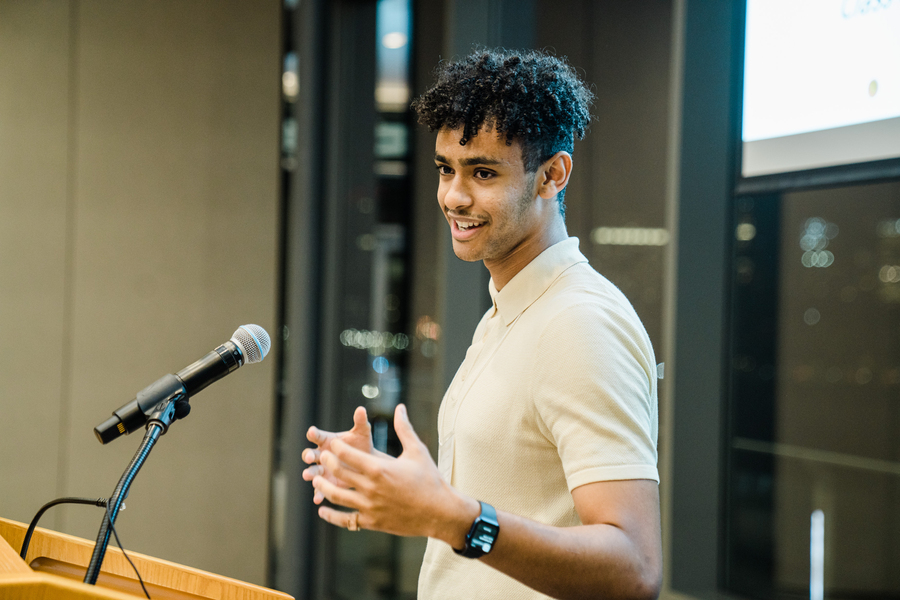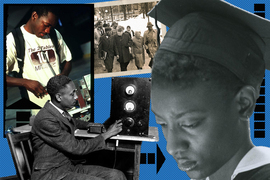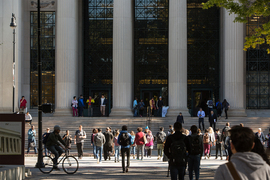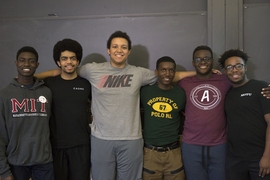On a clear, moonlit evening, a group of MIT undergraduate men of color gathered at the Samberg Center for a now-annual tradition: inducting the newest cohort of first-year students to The Standard, the Office of Minority Education’s program for undergraduate men of color. The gathering was festive, featuring dinner and a spectacular view of Boston, along with inspiring remarks by Chancellor Melissa Nobles and Institute Community Equity Officer John Dozier.
“The event was a celebration of all the cohorts, past and present, and it was great to feel the love and support of the Standard community,” recalls Justin Okorie, one of the first-year inductees that evening.
The Standard’s mission is to “holistically support the academic, personal, and professional success of MIT's undergraduate men of color.” But ask any member to describe their experience, and chances are they’ll single out the powerful sense of community that Okorie sensed that night. “Being a part of the Standard is a family like no other,” says Miles George ’22 who, along with his twin brother Malik George ’22, participated in The Standard. Both of them are still involved as alumni mentors, as they pursue their PhDs in biological engineering at the Institute.
Tailored and dynamic programming
Students who apply and are accepted to The Standard are asked to remain in the program for all four years, regularly attend program events, meet with Office of Minority Education (OME) staff for periodic check-ins, and maintain their GPA and academic progress. In return, they can participate in a wide variety of programming, from workshops on financial literacy, life skills, and professional development to social events like dinners, fun outings in and around Boston, and an annual retreat off campus. OME staff and faculty and alumni mentors provide valuable guidance and advice for the roughly 75 members as they progress along their academic and personal journey.
Some of the programming is tailored to each cohort’s stage and needs. First-years generally spend time getting to know upper-level students, as well as their classmates; for example, The Standard staff creates “family tree” groups consisting of one member of each class year, so that the sense of community cuts across age and stage. Sophomores focus on how to take on a mentorship role with younger students, and juniors and seniors take part in career and professional development workshops to prepare them for life after MIT. Throughout their time with The Standard, there are ample opportunities to discuss important themes such as masculinity, racism, intersectional identities (such as what it means to be a man and a man of color), and well-being. The program also hosts events that allow students to interact with men of color on the faculty and in industry.
One hallmark of The Standard is that it’s inherently dynamic. “The need is always changing from year to year, and it’s our job to keep listening and see what we can implement,” says OME Assistant Dean for Development Programs Gregory Jain, who oversees The Standard. For example, the program provides each student with financial resources for professional development, professional attire for interviews, grad school applications, and books. This year, members pointed out that many jobs require LinkedIn profiles, so Jain arranged to bring in a photographer to take professional-quality photos for them.
Opening minds and doors
Students involved in The Standard often find that it helps them grow in unexpected ways. “One thing I love about The Standard is how mind-opening it is; it exposes you to a lot,” says junior Bruke Wossenseged. A workshop about finding purpose in your life during his sophomore year was particularly impactful. “We were thinking about the future, about where you want to be in 10 years, where you want to be in five years … it just got me thinking about how I can shape my MIT experience to build a life that I want to be happy.”
Alonso Hernandez, a sophomore, participated in thought-provoking workshop about forming your personal narrative, which was facilitated by staff from the Intercultural Engagement team. “How do you tell your story in a way that is resonant with exactly how it’s been experienced by you, and also how can you communicate those same ideas to others? That was really eye-opening for me to be able to hear all these stories that my fellow Standard members had, and how they were similar or different from mine,” he says.
The annual retreat is another opportunity for self-reflection, says Malik George. “When you’re at a school like MIT, it’s so easy to get bogged down in work, and you kind of end up on this autopilot of constantly doing. The Standard has really helped me slow down and focus on myself in a way that I don’t think I would have been able to do in any other space. Thinking about my passions, who I am and what I want to do, as well as from a societal standpoint what it means to be a man of color in higher education. How society affects me as a man of color but also how, as a man of color, the kind of impacts we put out, both positive and sometimes negative, on the world or even other identities and other communities. That increased awareness of our identity and how that shapes our interactions with the world was a really unique experience.”
For Malik George and his brother Miles, the program also paved the way to graduate school — a path that they might not necessarily have considered otherwise. “A lot of times, The Standard can be a great gateway to the other initiatives that OME does,” Jain explains. Staff from The Standard recognized how much the twins liked research and encouraged them to apply for Laureates and Leaders, OME’s pathway to graduate school program for sophomores. Having the support and expertise of staff that could “transfer that knowledge to us about academia, and what research at an upper level looks like is knowledge we never would have had if it weren’t for The Standard,” Miles says.
Taking the long view
Looking ahead, Jain will continue to build and grow The Standard, in response to students’ evolving needs. The demand is there; this year’s cohort of 28 first-years is the largest one that the program has ever had. He plans to work on expanding the pool of alumni and faculty men of color, both as role models and for informal networking.
In the meantime, given the success of The Standard, this semester the OME is piloting a similar program for women of color, called the CRWN (for Creative Regal Women of kNowledge). The CRWN drew 40 students to a February information session and will host a women of color panel, study breaks, and others event this spring before its official launch this fall.
Ultimately, Jain hopes The Standard will follow in the footsteps of Interphase EDGE, a scholar-enrichment program that OME launched in 1969. “One thing I tell Standard students is, it may seem very small now, but this is something where I hope you’ll be able to look back 50 years from now and say, ‘I was part of that program.’ The work they are putting into it now is for the long term.”

